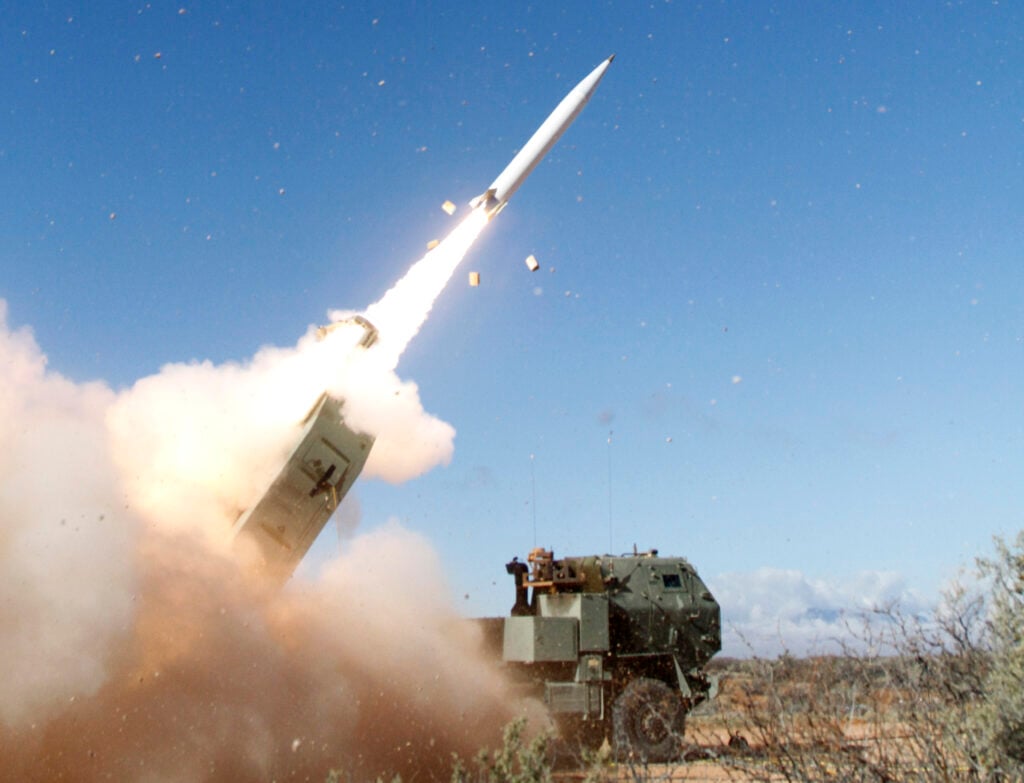
Lockheed’s prototype Precision Strike Missile (PrSM) fires from an Army HIMARS launcher truck
WASHINGTON: The Army just wrapped up its first Project Convergence exercise in the Yuma Desert, but it’s already wrestling with a potential problem for next year: Yuma Proving Ground’s 2,000 square miles of restricted airspace may be too small.
It’s hard to find a better metaphor for the scale of the Army’s ambitions. The service aims to grow the range of its weapons – and its role in future wars with Russia or China – to strike targets once reachable only by airpower.
The specific issue? The chief of Army Futures Command, Gen. John “Mike” Murray, wants to include the new Precision Strike Missile now in prototyping to replace the Reagan-era ATACMs. “PrSM missile, we haven’t shot it at its max range yet,” he told reporters. “If everything goes well – knock on wood – it will be part of Project Convergence next year, with a 500-plus kilometer shot [310+ miles]. Can’t do that here.”

Gen. John “Mike” Murray (left) speaks to Army Secretary Ryan McCarthy (right)
After Murray’s Wednesday press conference with top Army leaders, I followed up with his director for Long Range Precision Fires, artillery Brig. Gen. John Rafferty. This year’s Project Convergence included test shots at Yuma from a prototype armored howitzer called Enhanced Range Cannon Artillery (ERCA), which can use rocket-boosted shells to reach over 60 km (about 40 miles), twice as far as current cannon. Rafferty also took the ERCA vehicle for a test drive.
“Our goal for Project Convergence 21 is to get PrSM involved,” he told me, “and then also potentially some of the strategic systems” – such as the Long-Range Hypersonic Weapon, whose classified range is likely thousands of miles — “whether it’s in an actual [launch] or a virtual participation.”
Even the largest military installation in the continental US, White Sands Missile Range in New Mexico, is only about a hundred miles end to end. Longer test shots are generally fired over the ocean, using ranges like Kwajalein in the Pacific. But the point of Project Convergence, the very reason for the name, is to put together multiple types of tactics and technology, from drones to robots, and test how they work together as a combined-arms force – and land units can’t walk on water.
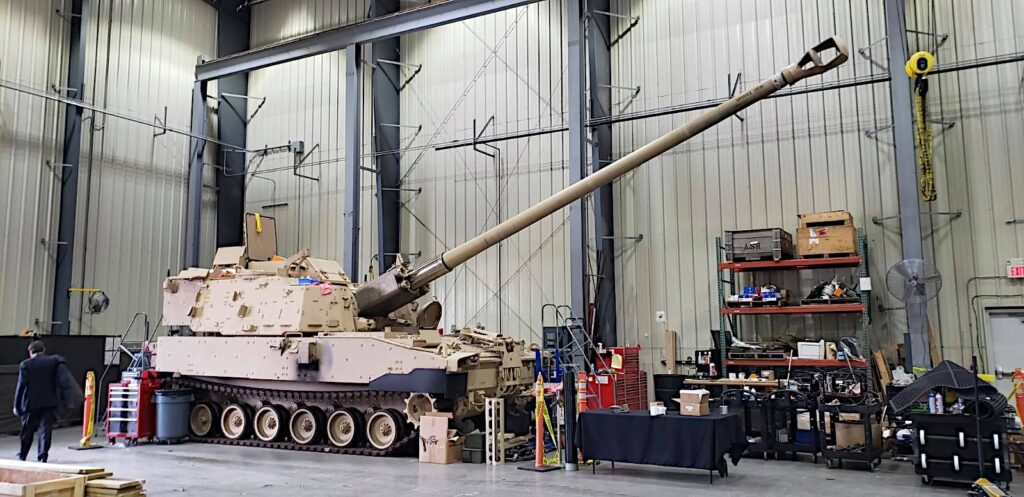
The prototype XM1299 Extended Range Cannon Artillery (ERCA) armored howitzer being assembled at Picatinny Arsenal, NJ.
For next year’s exercise, Murray suggested the Army might piece together multiple ranges and exercise areas that aren’t contiguous, such as Yuma and the National Training Center at Fort Irwin, California – “which comes with all kinds of problems with the FAA.” While he didn’t elaborate, presumably the idea would be to test short-range tactical firepower at one location, then fire long-range missiles in support from another site, which would require FAA clearance to use the intervening airspace.
The good news is the Army’s communications systems can transmit targeting data over these distances – despite not originally being designed to do so. That’s something the service proved this fall, with satellites in orbit sending imagery and other intelligence to a simulated theater headquarters at Joint Base Lewis-McChord in Washington State, which then relayed specific targets to weapons to Yuma, over 1,300 miles south.
In fact, the electronic “kill chain” that the Army’s building to connect other services’ long-range sensors to its new long-range shooters is increasingly agnostic about which sensors and shooters you plug in.
“The sensor and the shooter are unimportant. It’s the pathway,” said the exercise director, Brig. Gen. Richard Ross Coffman. “Once the pathway was proven, it could be against any target with any shooter.”
During Project Convergence, for example, the artillery corps’ AFATDS software was able to accept sensor data from Marine Corps F-35B fighters, Rafferty said: “That may have been a first.”
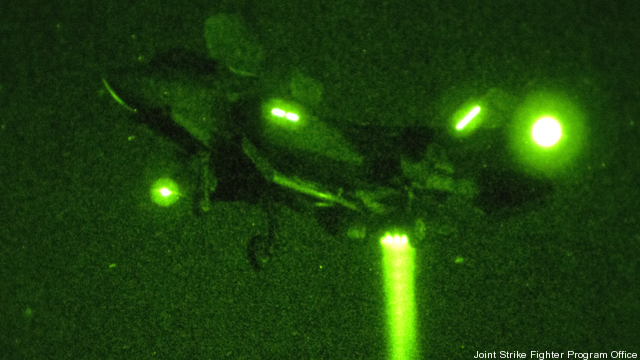
A Marine F-35B in vertical landing mode.
“Frankly, we didn’t know it could be done,” Coffman told me. When Project Convergence kicked off six weeks ago, he said, the plan was to test air-to-air communications between Army aircraft at Yuma Proving Ground and Marine aircraft — F-35 fighters and V-22 Osprey tiltrotors — operating out of Marine Corps Air Station Yuma next door. “About week two, I said, ‘Well, why aren’t we including the ground in this? And we set it as a goal, and we did it.”
“They were able to pass targeting data to the F-35s, so then the F-35s would have the ability to mission targets,” Coffman said, “and the F-35 was able to pass data to us on the ground to engage with indirect fires.”
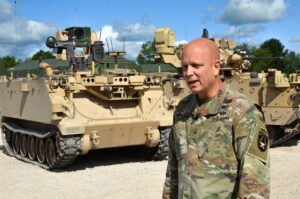
Brig. Gen. Richard Ross Coffman during a Robotic Combat Vehicle demonstration.
Coffman wouldn’t disclose the details of how the F-35 and AFATDS were connected, saying that was information adversaries could misuse. But the connection was made using “systems that are resident in units today,” suitably modified, without having to develop some new technology.
Critically, the ones and zeros were relayed machine to machine to machine though various digital intermediaries — without a human having to manually re-enter data from one system to the next, the standard workaround used in military command posts today.
Other links in Project Convergence did require human intervention, notably manually entering zeroes to change eight-digit Target Intelligence Data (TIDAT) coordinates used by satellite ground terminals into the 10-digit format used by AFATDS. The Army aims to fix that for next year – and also to roll out a new artificial intelligence system specifically for the artillery.
Project Yuma this fall and an earlier exercise this February in Germany tested an AI called Prometheus, which analyses satellite data, spots enemy forces, and sends targeting data to shooters. But the artillery corps is working on a complementary AI called SHOT (Synchronized High-Optempo Targeting), which will take targeting data from Prometheus and other sources, match it against the commander’s priorities and an Attack Guidance Matrix stating which types of targets are best attacked by which types of weapons. Then SHOT will output an automated call-for-fire, something missing from this year’s exercises.
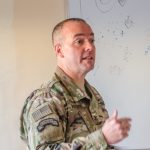
Then-Col. John Rafferty teaches field artillery operations in Tajikistan.
The Army had planned to use SHOT this year – in some briefings it even sounded as if it had done so – but it turned out there wasn’t sufficient funding available to complete the prototype in time. Experts from the SHOT team worked on the exercise to learn what the new tactics and weapons required, Rafferty said, and the software should be ready next year, running on the ADV ground terminal that receives intelligence data from satellites.
“We want all the intelligence we can get,” Rafferty said. “We want to access all the sensors that we can get.” But the Army’s learning it doesn’t need to overload the network – and soldiers’ brains – by sending everyone every piece of data. Instead, the AI needs to smart enough to send each user only as much information as they need: While an intelligence analyst might need high-res pictures of the target, for example, a cannoneer might just need the right coordinates to shoot at.
“The information needs to go to the right command post at the right time and in the right level of fidelity,” Rafferty told me. “We’ve got to respect the network, and we can’t overwhelm it with everything.”
Army eyes TBI monitoring, wearable tech for soldiers in high-risk billets
“We are also looking at what additional personal protective equipment we can provide to our folks, especially instructors and others who are routinely exposed to blast pressure,” said Army Secretary Christine Wormuth.


























